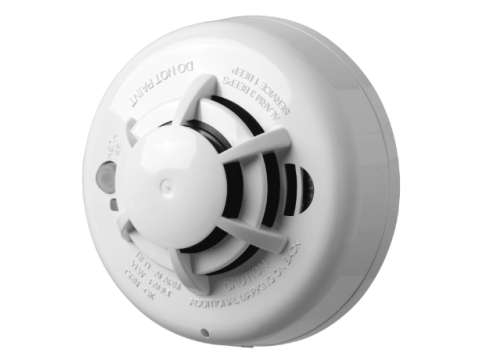A smoke detector in a fire alarm system monitors changes in the optical density of the air—i.e., how “cloudy” the air becomes with smoke. Once the concentration surpasses a set threshold, the detector signals the fire alarm control panel (FACP) or triggers an onboard siren if it’s a standalone model. Below, we’ll review the types of smoke detectors, their key advantages, and tips for proper placement and installation.
Smoke Detector Types: Spot vs. Beam
In fire protection systems, optical (photoelectric) smoke detectors can feature either a spot (point) or linear (beam) detection zone.
1. Spot (Point) Detectors
- Compact Housing: A small, labyrinth-style “smoke chamber” houses an infrared (IR) light source and receiver.
- Ceiling Mount: Commonly installed on ceilings, each device monitors a specific portion of the room’s air.
- Typical Coverage: The coverage area depends on the room’s square footage, ceiling height, and other layout considerations.
2. Beam (Linear) Detectors
- Long-Range Coverage: An IR beam is transmitted across the protected area to a receiver (or a reflector if it’s a single-unit design).
- Wall Mount: Usually set near the ceiling, but on opposite walls.
- Applications: Ideal for large-volume spaces (e.g., warehouses, gymnasiums) where installing multiple spot detectors would be impractical or expensive.
Wired vs. Wireless Smoke Detectors
Wired Detectors
- Stable & Compatible: Most common in commercial fire alarm setups, they draw power from the panel and connect via dedicated cabling (e.g., 2- or 4-wire circuits).
- No Battery Swaps: Reduced maintenance since they rely on the control panel’s power.
- Easier Cross-Brand Integration: Generally compatible with many fire alarm control units as long as the panel supports that type of detector.
Wireless Detectors
- No Cable Runs: Simplifies installation by cutting down on wiring. Ideal for retrofit scenarios or buildings where cable routing is difficult.
- Battery-Powered: Requires periodic battery checks and replacements, potentially problematic in high ceilings or if you have many detectors.
- Compatibility Constraints: Often limited to a specific manufacturer’s wireless protocol or product line.
Placement & Installation
Regardless of whether you choose wired or wireless, correct placement follows national and local fire codes (e.g., NFPA 72 in the US) or regional equivalents. Some key considerations:
- Room Layout & Ceiling Height
- Higher ceilings (>10–12 feet) may benefit from beam detectors or a combination approach.
- Obstructions
- Avoid installing detectors in corners, near fans, or in areas with significant airflow that could delay smoke reaching the sensor.
- Number of Detectors
- Fire codes often mandate overlapping coverage and/or two detectors in critical areas for redundancy.
- False Alarms
- Some control panels have a “double-detector” rule to reduce false alarms—two smoke detectors must trip before sounding an evacuation alarm.
Pro Tip: For non-regulated installations (e.g., a private house), a simplified approach can be used—reference the manufacturer’s stated coverage area. But in any occupancy covered by formal fire codes, a certified professional must ensure compliance with relevant standards.
Standalone (Autonomous) Smoke Detectors
In a standalone device, the detector, alarm siren, and battery power source are all housed within a single unit. Typically:
- No External Panel: It can operate independently of a larger fire alarm system.
- Local Alert Only: The built-in siren may be loud enough to wake someone in the same room but may not alert people in distant rooms.
- Use Case: Ideal for small residential settings or as a supplementary measure. For example, it can help ensure a sleeping individual is alerted if a fire starts at night.
Linking Standalone Detectors
Some models allow interconnection of multiple standalone units using a two-wire link or wireless pairing. If one detector senses smoke, all linked units sound their alarms simultaneously—extending the warning throughout the premises.
Common Issues: “Why Is It Beeping?”
- Battery Low: A periodic “chirp” often means the battery is weak and needs replacing.
- False Alarm: Smoke from cooking, steam, or dust can cause nuisance alarms; relocate or clean the device if this is a frequent problem.
- Malfunction: Manufacturers typically include a LED indicator or an audible signal for fault conditions.
Testing & Maintenance
- Automatic Self-Monitoring
- Many modern smoke detectors monitor internal components and warn of faults with LED indicators or short beeps.
- Manual Test Button
- Pressing the “Test” button simulates an alarm condition, verifying the unit’s ability to detect and sound.
- Regular Cleaning
- Especially for dusty environments, gently vacuum or use compressed air to clear the sensor openings.
Final Thoughts
Smoke detectors remain the backbone of most fire detection systems. For commercial or code-regulated properties, wired, panel-connected devices typically provide robust coverage and central monitoring. Wireless sensors help in specific retrofit or aesthetic-focused scenarios—just remember battery maintenance and potential compatibility challenges. Meanwhile, standalone units offer a quick, budget-friendly layer of protection, especially in smaller or privately owned buildings.
Key Reminders:
- Follow Local Codes: Use official guidelines (e.g., NFPA 72) to determine the placement and number of sensors.
- Consider Environment: High ceilings, dust, or other conditions may warrant beam detectors or special sensor calibrations.
- Plan for Redundancy: Fire systems often use multiple detectors or “double-detection” logic to reduce false alarms while ensuring rapid response.
- Maintenance: Regular checks, battery replacements (for wireless or standalone models), and cleaning keep detectors reliable.
For personalized advice on choosing and installing smoke detectors, or to explore code-compliant fire alarm solutions, visit safsale.com. Our experts can help tailor a fire detection setup that best protects your property.

